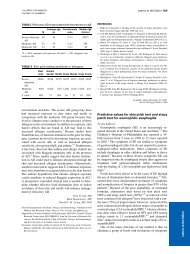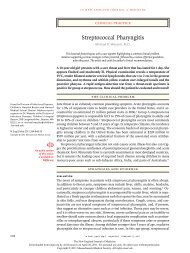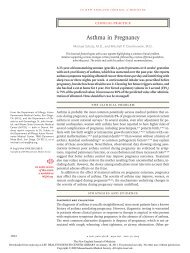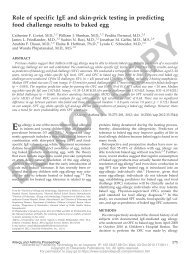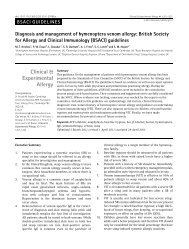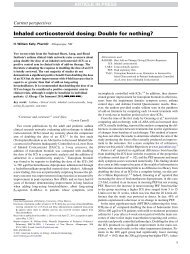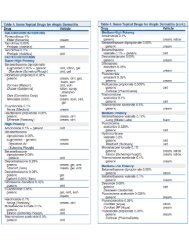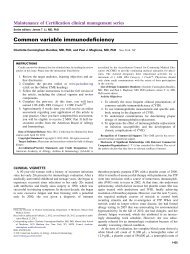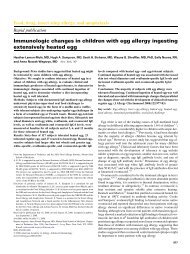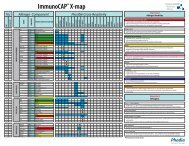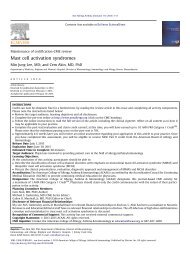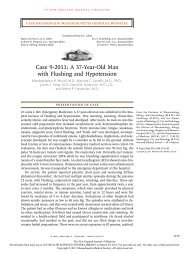Factors affecting the determination of threshold doses for - AInotes
Factors affecting the determination of threshold doses for - AInotes
Factors affecting the determination of threshold doses for - AInotes
You also want an ePaper? Increase the reach of your titles
YUMPU automatically turns print PDFs into web optimized ePapers that Google loves.
26 Taylor et al J ALLERGY CLIN IMMUNOLJANUARY 2002<strong>the</strong> <strong>of</strong>fending food, including milk in 9 incidents at levelsranging from 0.04% to 1.1% (wt/wt), egg in 3 incidentsat levels ranging from 0.003% to 0.16% (wt/wt),wheat gluten in 2 incidents at levels ranging from 0.3%to 1.3% (wt/wt), soy protein in 2 incidents at levels rangingfrom 0.5% to 7.0% (wt/wt), and hazelnut in 1 incidentat a level <strong>of</strong> 0.2% (wt/wt). Quantitative exposurein<strong>for</strong>mation was available in several <strong>of</strong> <strong>the</strong>se cases. Fatalanaphylaxis occurred in a consumer with milk allergyafter eating approximately 100 g <strong>of</strong> a sausage productcontaining 0.06% undeclared casein that equated to 60mg <strong>of</strong> casein. 8 An asthmatic reaction occurred in an individualwith hazelnut allergy after ingestion <strong>of</strong> about 3 to6 g <strong>of</strong> a chocolate confection containing 0.2% <strong>of</strong> undeclaredhazelnut that equated to 6 to 12 mg <strong>of</strong> hazelnut. 8Although such episodes reveal <strong>the</strong> hazards posed byundeclared residues <strong>of</strong> allergenic foods contaminatingo<strong>the</strong>r foods, <strong>the</strong>y are not particularly suitable <strong>for</strong> establishing<strong>the</strong> lowest provoking dose. For example, <strong>the</strong> circumstances<strong>of</strong> exposure, including <strong>the</strong> amount and type<strong>of</strong> foods eaten during <strong>the</strong> episode, can only be determinedanecdotally. Also, <strong>the</strong> reliability <strong>of</strong> <strong>the</strong> analyticresults can be questioned because validated, collaborativelystudied, standard methods are not yet available.CLINICAL APPROACHES TO THRESHOLDDOSE ESTIMATIONThe best estimates <strong>of</strong> <strong>the</strong> <strong>threshold</strong> dose <strong>for</strong> variousallergenic foods can be obtained from controlled clinicalchallenge trials. In only a few cases were such trials intendedspecifically to determine <strong>the</strong> <strong>threshold</strong> dose. 5,9 More frequently,challenges have been conducted <strong>for</strong> diagnosticpurposes ra<strong>the</strong>r than <strong>for</strong> determining <strong>the</strong> lowest provokingdose. However, typical protocols involve starting at <strong>doses</strong>that are one half or less <strong>of</strong> <strong>the</strong> amount <strong>of</strong> <strong>the</strong> <strong>of</strong>fending foodestimated by <strong>the</strong> patient to provoke symptoms. 10Because low <strong>doses</strong> <strong>of</strong> allergenic foods are sometimesused in <strong>the</strong> diagnosis <strong>of</strong> food allergies, especially inpatients with histories <strong>of</strong> serious allergic reactions, <strong>the</strong>possibility exists that data on <strong>the</strong> <strong>threshold</strong> <strong>doses</strong> <strong>for</strong>common allergenic foods might exist in certain allergyclinics. Consequently, in September 1999, <strong>the</strong> FoodAllergy Research and Resource Program at <strong>the</strong> University<strong>of</strong> Nebraska, with sponsorship from <strong>the</strong> food industry,convened a roundtable conference entitled “ThresholdDoses <strong>for</strong> Allergenic Foods: How Much Is Too Much?”RESULTS OF THE ROUNDTABLESeveral clinical groups did possess potentially usefulin<strong>for</strong>mation relating to <strong>the</strong> <strong>threshold</strong> <strong>doses</strong> <strong>for</strong> commonlyallergenic foods derived from <strong>the</strong> results <strong>of</strong> past doubleblind,placebo-controlled, food challenges (DBPCFCs)used <strong>for</strong> diagnostic purposes. The most useful data wereavailable on peanuts, eggs, and cows’ milk and will bereported here. Some data were also available on fish andmustard seed. Data were also available <strong>for</strong> soybeans,wheat, sesame seed, tree nuts, and crustaceans, but <strong>the</strong>number <strong>of</strong> patients tested was too few, and in some cases,<strong>the</strong> nature <strong>of</strong> <strong>the</strong> challenge materials was not preciselyknown (eg, <strong>the</strong> variety <strong>of</strong> tree nuts, <strong>the</strong> <strong>for</strong>m <strong>of</strong> soybean,and <strong>the</strong> method <strong>of</strong> processing or species <strong>of</strong> crustacean).Table I contains <strong>the</strong> results <strong>of</strong> <strong>the</strong> accumulated data on<strong>the</strong> lowest provoking <strong>doses</strong> in DBPCFCs <strong>for</strong> <strong>the</strong> variousinvestigators involved in <strong>the</strong> roundtable conference <strong>for</strong>peanuts, eggs, and cows’ milk. For peanut, results wereshared on DBPCFCs (and some single-blind, placebocontrolledfood challenges [SBPCFCs] and open challenges)<strong>of</strong> 306 patients. The lowest provoking dose was 1mg <strong>of</strong> peanut, which was seen with 4 patients; all <strong>of</strong> <strong>the</strong>sepatients were from <strong>the</strong> clinic <strong>of</strong> Dr Fabienne Rance inFrance. The range <strong>of</strong> lowest provoking <strong>doses</strong> <strong>for</strong> <strong>the</strong>sepatients was 1 mg to 5 g. For eggs, results were shared onDBPCFCs (and some SBPCFCs and open challenges) <strong>of</strong>281 patients. The lowest provoking dose was 1 mg <strong>of</strong> liquidwhole egg, which was seen with 2 patients, both from<strong>the</strong> clinic <strong>of</strong> Dr Rance in France. The range <strong>of</strong> lowestprovoking <strong>doses</strong> <strong>for</strong> <strong>the</strong>se patients was 1 mg to 5 g. Forcows’ milk, <strong>the</strong> results are much more difficult to interpretbecause several different <strong>for</strong>ms <strong>of</strong> cows’ milk wereused in <strong>the</strong> challenges: liquid cows’ milk, nonfat drymilk, and infant <strong>for</strong>mula. For cows’ milk, results wereshared on DBPCFCs (and a few SBPCFCs and openchallenges) <strong>of</strong> 299 patients. The lowest provoking dosewas 0.02 mL <strong>of</strong> milk, which was seen in 21 patients; all<strong>of</strong> <strong>the</strong>se patients were from <strong>the</strong> clinic <strong>of</strong> Dr David Hillfrom Australia. The range <strong>of</strong> lowest provoking <strong>doses</strong> <strong>for</strong><strong>the</strong>se patients was 0.02 mL to greater than 100 mL. Forfish, <strong>the</strong> lowest provoking dose was 5 mg <strong>of</strong> ei<strong>the</strong>r cod orherring, as determined from <strong>the</strong> results <strong>of</strong> DBPCFCs(and some SBPCFCs) on 32 patients. However, <strong>the</strong>species <strong>of</strong> fish used in <strong>the</strong>se challenges were variable,and this appeared to affect <strong>the</strong> results, as noted fromcomparative in<strong>for</strong>mation obtained on 14 patients <strong>for</strong> 4different species by Dr Carsten Bindslev-Jensen in Denmark.Fifteen individuals with mustard allergy have beenevaluated by means <strong>of</strong> DBPCFCs in France, and <strong>the</strong> mostsensitive individual reacted to 1 mg <strong>of</strong> ground mustardseed. To apply this in<strong>for</strong>mation in <strong>the</strong> context <strong>of</strong> a typicalserving <strong>of</strong> food containing undeclared residues <strong>of</strong> anallergenic food, 1 mg <strong>of</strong> an allergenic food in a typical50-g serving would be equivalent to 20 mg <strong>of</strong> allergenicfood per kilogram <strong>of</strong> <strong>the</strong> ingested food product (20 ppm).DISCUSSIONClearly, sufficient results are available to conclude that<strong>the</strong> <strong>threshold</strong> <strong>doses</strong> <strong>for</strong> commonly allergenic foods arefinite, measurable, and above zero. However, attemptingto reach consensus on <strong>the</strong> <strong>threshold</strong> <strong>doses</strong> <strong>for</strong> peanut,egg, cows’ milk, fish, and mustard on <strong>the</strong> basis <strong>of</strong> <strong>the</strong>existing data would probably be premature <strong>for</strong> a number<strong>of</strong> reasons. The number <strong>of</strong> patients who have been subjectedto DBPCFCs with low <strong>doses</strong> <strong>of</strong> <strong>the</strong> <strong>of</strong>fending foodis probably sufficient to estimate <strong>the</strong> <strong>threshold</strong> dose atleast <strong>for</strong> peanut, egg, and cows’ milk. However, <strong>the</strong>nature <strong>of</strong> <strong>the</strong> data suggests that it may be premature to



